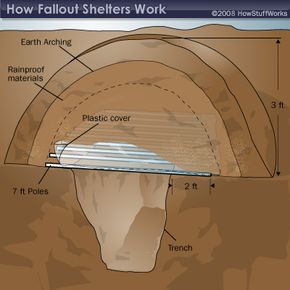How to Build a Fallout Shelter
If a nuclear attack occurs far away and you aren't close to a private or public shelter, it's possible to build your own. One type of fallout shelter that can easily be made by a typical family in a short amount of time is a pole-covered trench. It's simply a hole in the ground covered by a roof of poles and a mound of earth. In the event of a nuclear attack, this general checklist of items would make building this type of fallout shelter much easier.
- Tools - Shovels to dig earth, picks for hard ground, saws or axes for cutting poles and knives are necessary. Other useful items include cans, buckets, pots and pans, which can be used for carrying earth and eventually for storing water; measuring tapes to measure the length, width and depth of the shelter; flashlights, ropes, hammers, pliers, work gloves and medical kits.
- Rainproof material - Anything including shower curtains, tablecloths, mattress covers and canvas will work.
- Water - Fifteen gallons of drinking water is recommended to last people inside the shelter as long as possible. It may be necessary to stay inside a fallout shelter for as much as two weeks after a nuclear attack, so sufficient amounts of water will guarantee survival.
- Homemade air ventilation - Because our bodies give off water vapor, the insides of a fallout shelter would quickly become unbearably hot without proper ventilation. This page provides instructions for building a Kearny Air Pump (KAP), a simple yet effective way of circulating air while allowing minimal, safe amounts of radiation into the shelter.
To begin, you should stake the outlines of your trench with shafts of wood. The shelter should be located at least 50 feet away from any large buildings, because nuclear explosions can cause far-reaching firestorms and damage structures well past ground zero. Once you have decided upon appropriate dimensions, start digging away earth and cutting poles to the appropriate length. The poles are placed across the trench, and their ends should extend at least two feet past the edges.
Advertisement
Cover any cracks between the logs with cloth or anything that will stop dirt from falling into the shelter. Two 6-foot poles, one placed onto top of the other and secured with rope, can be placed in front of the entrance to keep dirt from spilling in. One layer of earth, about a foot and a half deep, should go on top of the poles. The waterproofing material listed above goes on top of this first layer, and finally another foot and a half of earth is placed on top.
For lots more information on nuclear bombs, nuclear radiation and other things nuclear, see the next page.
Related HowStuffWorks Articles
More Great Links
Sources
- Kearny, Cresson. "Nuclear war survival skills." U.S. Department of Energy - Oak Ridge National Laboratory. Oregon: Oregon Institute of Science and Medicine, 1986.
- National Conference of States on Building Codes and Standards. "Standards for fallout shelters." Federal Emergency Management Agency. Sept. 1979.
- Office of Civil Defense. "Fallout protection for homes with basements." Department of Defense. May 1967. http://www.infomercantile.com/-/Fallout_Protection_For_Homes_With_Basements
- Zacharias, Pat. "When bomb shelters were all the rage." The Detroit News. April 1, 1999. http://info.detnews.com/redesign/history/story/historytemplate.cfm?id=48
